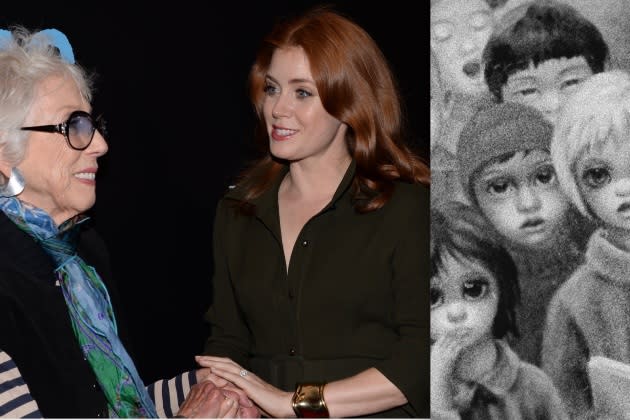Margaret Keane Dies: Kitschy ‘Big Eyes’ Artist, Subject Of Tim Burton Biopic Was 94
- Oops!Something went wrong.Please try again later.
- Oops!Something went wrong.Please try again later.
- Oops!Something went wrong.Please try again later.
- Oops!Something went wrong.Please try again later.

Margaret Keane, whose popular paintings of big-eyed, melancholy children became one of the most widely recognized signature artistic styles of the late 20th century — and whose long battle with her husband over his fraudulent and lucrative claims of authorship inspired the 2014 Tim Burton film Big Eyes starring Amy Adams — died Sunday at her home in Napa, CA. She was 94.
Her death was reported on her official Facebook page today, and her daughter Jane Swigert told The New York Times that the cause of death was heart failure.
More from Deadline
Depeche Mode Discloses Andy Fletcher Cause Of Death - Update
Ken Williams Dies: "Everybody Plays The Fool" Songwriter Was 83
Hollywood & Media Deaths In 2022: Photo Gallery
Keane’s instantly recognizable paintings of children, typically portrayed and described as waifs with huge, sad and dinner-plate-sized eyes, became massively popular in the 1950s and ’60s, at first sincerely and later as totems of kitsch as iconic as plastic pink flamingoes.
According to various biographies, Keane began painting as a child, and at 18 attended the Traphagen School Of Design in New York City. She began painting portraits in the 1950s, showing an inclination toward deliberate kitsch even then.
Her career took off – or, rather, her second husband’s career – in the mid-1950s when that husband, Walter Keane, began marketing the “big eyes” paintings and selling them at the Hungry in a comedy club in San Francisco, in New York City’s Washington Square and during Mardi Gras in New Orleans. Unbeknownst – at first – to Margaret, Walter Keane claimed he was the artist, with the soon-to-be familiar “Keane” signature offering the public no evidence to the contrary.
Margaret Keane would eventually go along with the ruse, later saying she feared for the safety of herself and her daughter at the hands of the abusive Walter.
However duplicitous, Walter Keane’s ruse was both successful and lucrative. What he lacked in artistic talent he made up for in salesmanship: He appeared on late-night talk shows, in major magazines and made national headlines when a “Walter Keane” painting was accepted – and, following criticism from a New York Times art critic, rejected – for prominent display at the 1964 New York World’s Fair.
The publicity and the innate appeal of the sentimental artworks resulted in a cultural phenomenon and, for the Keanes, a financial windfall. According to the Times, prints of the paintings grossed $2 million in 1964 alone, and originals soon hung in museums around the world. Andy Warhol was a fan, and celebrities from Zsa Zsa Gabor and Liberace to Natalie Wood and Jerry Lewis commissioned portraits.
Even after the couple’s separation in the mid-1960s, the Keanes continued, more or less, the ruse, until in 1970 when Margaret announced that she was the true and sole artist of the works. During a 1986 court hearing in Hawaii, after she sued her ex-husband for defamation over his continued false claims, Margaret Keane dramatically challenged Walter to a painting contest, quickly proving to the court’s satisfaction that she was, indeed, the “big eyes” artist. She won $4 million in damages, but never saw a penny from the broke Walter Keane.
The Keanes’ eccentric story has proved as enduring as the paintings – prints remain popular emblems of kitsch and nostalgia even today – and in 2014 director Burton released Big Eyes, a biopic written Scott Alexander and Larry Karaszewski, with Amy Adams playing Margaret and Christoph Waltz as Walter. Well-received by critics, the film earned Adams a Golden Globe Award for Best Actress.
In a Facebook post today, screenwriter Karaszewski paid tribute to the artist. “Margaret Keane has passed on,” he wrote. “Grateful we all got to spend so much time getting to know her beautiful spirit. It took a decade to bring ‘Big Eyes’ to the screen. But her tale of surviving abuse was important. She wanted the world to know the truth about her life and art.”
In addition to her daughter, Keane is survived by five stepchildren and eight step-grandchildren.
Best of Deadline
2022-23 Awards Season Calendar - Dates For The Oscars, Emmys, Tonys, Guilds, Festivals & More
NFL 2022 Schedule: Primetime TV Games, Thanksgiving Menu, Christmas Tripleheader & More
Sign up for Deadline's Newsletter. For the latest news, follow us on Facebook, Twitter, and Instagram.

